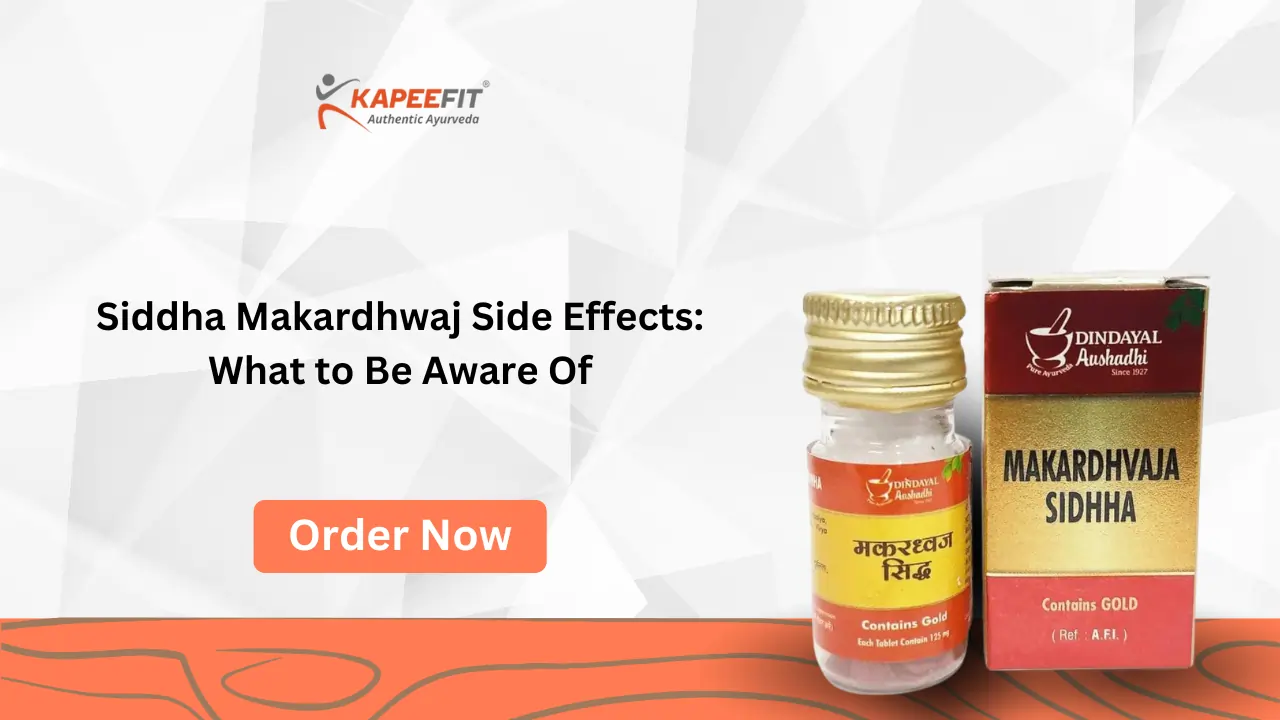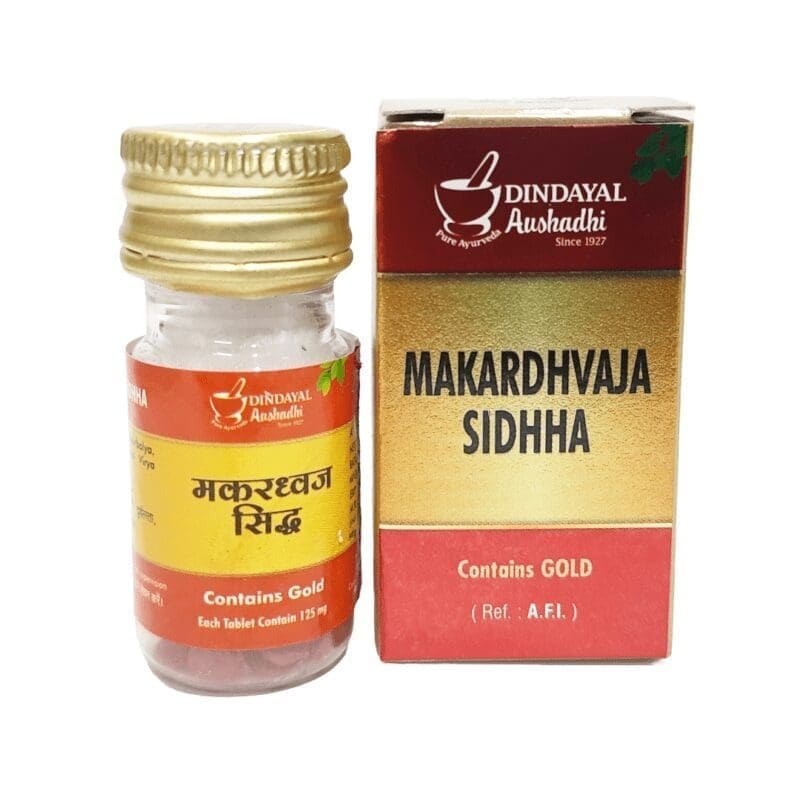Siddha Makardhwaj Side Effects: What to Be Aware Of


Siddha Makardhwaj Side Effects: What to Be Aware Of
Siddha Makardhwaj Side Effects, Siddha Makardhwaj ek popular Ayurvedic medicine hai jo centuries se use ki ja rahi hai. Ye ek potent formulation hai jise apne therapeutic properties ke liye jaana jaata hai. Lekin, jaise har medicine ke saath hota hai, iske bhi kuch side effects ho sakte hain jinke baare mein aapko aware hona chahiye. Is article mein, hum Siddha Makardhwaj ke baare mein detail mein discuss karenge, uske benefits, potential side effects, aur safe usage ke liye precautions ke baare mein baat karenge.
Table of Contents
Siddha Makardhwaj Kya Hai?
Siddha Makardhwaj ek mineral-based Ayurvedic formulation hai jo primarily mercury (parad), sulphur (gandhak), aur gold (swarna) se bana hota hai. Ise Ayurvedic texts mein ek powerful rasayana (rejuvenating agent) aur aphrodisiac ke roop mein describe kiya gaya hai. Traditional Ayurvedic practitioners ise various health conditions jaise ki sexual disorders, respiratory problems, aur general weakness ke treatment mein use karte hain.
Siddha Makardhwaj ke Benefits
Siddha Makardhwaj ko numerous health benefits ke liye use kiya jaata hai. Kuch main benefits include:
- Immunity Booster: Ye immune system ko strengthen karne mein help karta hai, jisse body ko infections se fight karne mein madad milti hai.
- Aphrodisiac Properties: Ise sexual health improve karne aur erectile dysfunction treat karne ke liye use kiya jaata hai.
- Anti-Aging Effects: Iske anti-aging properties hoti hain jo premature greying of hair aur wrinkles ko reduce karne mein help kar sakti hain.
- Respiratory Health: Ye chronic cough aur tuberculosis jaise respiratory conditions mein beneficial ho sakta hai.
- Cardiac Health: Ye heart function ko improve karne mein help kar sakta hai aur bradycardia (slow heartbeat) ke cases mein use kiya ja sakta hai.
- Digestive Aid: Ye digestion ko improve karne aur dyspepsia ko relieve karne mein help kar sakta hai.
- Energy Booster: Ye general weakness aur fatigue ko dur karne mein help kar sakta hai, providing overall vitality and stamina.
Siddha Makardhwaj ke Side Effects
Jabki Siddha Makardhwaj ke numerous benefits hain, iske potential side effects ke baare mein bhi aware hona important hai. Ye side effects mild se severe tak ho sakte hain, aur inme include ho sakte hain:
- Mercury Toxicity: Siddha Makardhwaj mein mercury hota hai, jo agar proper processing aur dosage na follow ki jaye to toxic ho sakta hai.
Mercury toxicity ke symptoms include:- Tremors
- Mood swings
- Insomnia
- Neuromuscular changes
- Headaches
- Cognitive and motor dysfunction
- Gastrointestinal Issues:
Kuch users ko following gastrointestinal problems face ho sakti hain:- Nausea
- Vomiting
- Diarrhea
- Abdominal pain
- Loss of appetite
- Kidney Problems:
Long-term ya excessive use se kidney function affect ho sakta hai, leading to:- Increased urination
- Kidney pain
- In severe cases, kidney failure
- Liver Damage:
Liver par bhi adverse effects ho sakte hain, jisme include ho sakte hain:- Jaundice
- Liver enlargement
- Elevated liver enzymes
- Neurological Effects:
Mercury central nervous system ko affect kar sakta hai, causing:- Numbness
- Tingling sensations
- Tremors
- Vision problems
- Memory issues
- Skin Reactions:
Kuch users ko skin-related issues face ho sakti hain:- Rashes
- Itching
- Skin discoloration
- Allergic Reactions:
Rare cases mein, severe allergic reactions ho sakti hain, jisme include ho sakte hain:- Difficulty breathing
- Swelling of face, lips, tongue, or throat
- Severe dizziness
- Cardiovascular Effects:
High doses ya prolonged use se following cardiovascular issues ho sakti hain:- Irregular heartbeat
- Chest pain
- High blood pressure
- Respiratory Issues:
Kuch cases mein, respiratory problems report ki gayi hain:- Shortness of breath
- Coughing
- Wheezing
- Endocrine Disruption:
Mercury endocrine system ko disrupt kar sakta hai, leading to:- Thyroid problems
- Hormonal imbalances
- Reproductive Issues:
Prolonged exposure se reproductive health affect ho sakti hai, causing:- Decreased fertility
- Menstrual irregularities
- Psychological Effects:
Kuch users ne following psychological issues report ki hain:- Anxiety
- Depression
- Irritability
- Mood swings
- Oral Health Problems:
Mercury exposure se oral health issues ho sakti hain:- Metallic taste in mouth
- Inflammation of gums
- Excessive salivation
- Eye Problems:
Rare cases mein, eye-related issues report ki gayi hain:- Blurred vision
- Eye irritation
- Changes in color vision
- Immune System Effects:
Long-term use se immune system weaken ho sakta hai, leading to:- Increased susceptibility to infections
- Autoimmune disorders
Siddha Makardhwaj Usage aur Dosage
Siddha Makardhwaj ka usage aur dosage bahut carefully determine kiya jana chahiye. Ye sirf qualified Ayurvedic practitioners ki supervision mein hi liya jana chahiye. General guidelines include:
- Standard Dosage: Typically, 1 to 2 tablets (about 125 mg each) daily ya as prescribed by an Ayurvedic physician.
- Administration: Usually honey ya warm milk ke saath liya jata hai.
- Duration: Treatment duration varies depending on the condition being treated, but generally should not exceed 2-3 months without medical supervision.
- Time of Intake: Preferably morning mein empty stomach par liya jata hai.
- Age Restrictions: Not recommended for children, pregnant women, ya breastfeeding mothers.
- Personalized Dosage: Dosage may be adjusted based on individual factors like age, weight, health condition, aur severity of the ailment.
Dindayal Makardhvaja Sidhha | Authentic Siddh Makardhwaj Vati | Buy Now for Vitality
Boost your vitality with Dindayal Makardhvaja Sidhha, a premium Ayurvedic formulation. This powerful makardhwaj vati enhances energy, stamina, and overall well-being. Experience the legendary benefits of siddha makardhwaj – order now and revitalize your life!
Ingredients
- Purified Mercury (Shuddha Parada)
- Purified Sulfur (Shuddha Gandhaka)
- Gold Bhasma (Swarna Bhasma)
- Herbs and minerals processed through traditional Ayurvedic methods
Precautions aur Safety Measures
Siddha Makardhwaj ke safe use ke liye, following precautions follow karna important hai:
- Medical Supervision: Always take under the guidance of a qualified Ayurvedic practitioner.
- Quality Assurance: Ensure ke aap reputable manufacturers se hi product purchase kar rahe hain jo proper quality control measures follow karte hain.
- Pre-existing Conditions: Inform your doctor about any pre-existing health conditions, especially liver or kidney problems.
- Drug Interactions: Inform about any other medications ya supplements you’re taking to avoid potential interactions.
- Pregnancy and Breastfeeding: Avoid during pregnancy and breastfeeding.
- Alcohol: Avoid alcohol consumption during the course of treatment.
- Diet Restrictions: Follow any dietary restrictions recommended by your Ayurvedic practitioner.
- Regular Monitoring: Regular health check-ups aur blood tests karwate rahein to monitor any potential side effects.
- Proper Storage: Store in a cool, dry place, away from direct sunlight and out of reach of children.
- Overdose Precaution: Never exceed the prescribed dose. In case of accidental overdose, seek immediate medical attention.
Siddha Makardhwaj ka Composition
Siddha Makardhwaj ka exact composition manufacturer ke according vary kar sakta hai, lekin generally, isme following ingredients hote hain:
- Parada (Mercury): The primary ingredient, carefully purified and processed.
- Gandhaka (Sulphur): Used in combination with mercury to form mercury sulphide.
- Swarna (Gold): Added in small quantities for its therapeutic properties.
- Other Ingredients:
Depending on the formulation, it may also contain:- Moti Bhasma (Pearl ash)
- Javitri (Nutmeg)
- Swarna Vanga (Tin ash)
| Ingredient | Sanskrit Name | Proportion |
|---|---|---|
| Mercury | Parada | 1 part |
| Sulphur | Gandhaka | 8 parts |
| Gold | Swarna | 1/8 part |
Siddha Makardhwaj ka Historical Context
Siddha Makardhwaj ka use ancient Ayurvedic texts mein trace kiya ja sakta hai. Iska name ‘Makardhwaj‘ mythological sea creature Makara se derive hua hai, jo power aur vitality ka symbol hai. Historically, ye formulation royalty aur wealthy individuals ke liye reserved thi due to its expensive ingredients aur complex preparation process. Ancient times mein, alchemists aur Ayurvedic practitioners ne is formulation ko develop kiya tha with the belief ki mercury, when properly processed with sulphur aur gold, could be transformed into a powerful medicine. Ye process ‘Rasashastra‘ ka part hai, jo Ayurveda ki ek branch hai jo mineral-based medicines se deal karti hai.
Siddha Makardhwaj Manufacturing Process
Siddha Makardhwaj ka manufacturing process complex aur time-consuming hota hai. Ye process ‘Kupipakwa Rasayana’ method ka use karta hai, jisme ingredients ko ek special glass bottle (Kachi) mein heat kiya jata hai. Here’s a simplified overview of the process:
- Purification: Sabse pehle, mercury aur sulphur ko purify kiya jata hai using traditional Ayurvedic methods.
- Mixing: Purified mercury aur sulphur ko specific ratios mein mix kiya jata hai.
- Trituration: Is mixture ko gold powder ke saath triturate kiya jata hai.
- Bottle Preparation: Ye mixture ek special glass bottle mein dala jata hai jo sand se surrounded hoti hai.
- Heating: Bottle ko gradually increasing temperatures par heat kiya jata hai, sometimes for several days.
- Cooling: Process complete hone ke baad, bottle ko slowly cool hone diya jata hai.
- Extraction: Cooled bottle ko carefully break kiya jata hai aur final product ko extract kiya jata hai.
- Processing: Final product ko process kiya jata hai aur tablet ya powder form mein prepare kiya jata hai.
Is entire process ko strictly controlled conditions mein perform kiya jata hai to ensure safety aur efficacy of the final product.
Siddha Makardhwaj aur Modern Medicine
Siddha Makardhwaj aur modern medicine ke beech relationship complex hai. While traditional Ayurvedic practitioners iske therapeutic benefits par believe karte hain, modern medical community iske use ko lekar concerned hai, primarily due to its mercury content.
Modern Medicine ka Perspective
- Mercury Toxicity Concerns: Modern medicine mercury ko ek toxic substance consider karti hai. World Health Organization (WHO) ne mercury aur its compounds ko one of the top ten chemicals of major public health concern ke roop mein listed kiya hai.
- Lack of Clinical Trials: Siddha Makardhwaj ke efficacy aur safety ko prove karne ke liye large-scale, controlled clinical trials ki kami hai.
- Regulatory Issues: Many countries mein, mercury-containing medicines ke sale aur distribution par strict regulations hain.
- Alternative Treatments: Modern medicine often recommends safer, clinically proven alternatives for conditions jiske liye Siddha Makardhwaj traditionally use kiya jata hai.
Ayurvedic Perspective
- Traditional Wisdom: Ayurvedic practitioners argue ki centuries of use aur documented benefits Siddha Makardhwaj ki safety aur efficacy ko demonstrate karte hain.
- Processing Methods: They believe ki traditional processing methods mercury ko non-toxic form mein convert kar dete hain.
- Holistic Approach: Ayurveda ek holistic treatment approach follow karta hai, jahan Siddha Makardhwaj ko often other herbs aur lifestyle changes ke saath prescribe kiya jata hai.
Bridging the Gap
Recent years mein, efforts kiye ja rahe hain to bridge the gap between traditional Ayurvedic practices aur modern scientific understanding:
- Scientific Studies: Kuch studies Siddha Makardhwaj ke various aspects ko investigate kar rahi hain, including its chemical composition aur biological effects.
- Standardization Efforts: There are ongoing efforts to standardize the preparation aur quality control of Ayurvedic medicines, including Siddha Makardhwaj.
- Integrative Approach: Some medical practitioners are exploring ways to integrate traditional Ayurvedic knowledge with modern medical practices for better patient outcomes.
Siddha Makardhwaj ke Alternatives
Given the concerns associated with Siddha Makardhwaj, particularly its mercury content, many individuals aur practitioners safer alternatives ki taraf move kar rahe hain. Here are some alternatives that may be considered for various conditions traditionally treated with Siddha Makardhwaj:
For Immunity Boosting
- Chyawanprash: A traditional Ayurvedic formulation made from various herbs and minerals, known for its immune-boosting properties.
- Ashwagandha: An adaptogenic herb that supports overall health and immunity.
- Amla (Indian Gooseberry): Rich in Vitamin C and antioxidants, it’s excellent for immune support.
- Giloy (Tinospora cordifolia): Known for its immune-modulating properties.
For Sexual Health and Vitality
- Shilajit: A natural substance known for its rejuvenating properties and benefits for male sexual health.
- Safed Musli: An herb traditionally used to enhance male vitality and sexual performance.
- Gokshura (Tribulus terrestris): Known for its benefits in improving libido and sexual function.
For Respiratory Health
- Sitopaladi Churna: An Ayurvedic formulation used for various respiratory issues.
- Talisadi Churna: Effective for cough, cold, and respiratory allergies.
- Kantakari (Solanum xanthocarpum): Used in Ayurveda for respiratory health.
For Digestive Health
- Triphala: A combination of three fruits that support digestive health and overall well-being.
- Hingwashtak Churna: An Ayurvedic formulation used for improving digestion and treating various digestive disorders.
- Avipattikar Churna: Known for its effectiveness in treating acidity and other digestive issues.
For General Health and Vitality
- Shatavari: An herb known for its rejuvenating properties, particularly beneficial for women’s health.
- Brahmi: Supports cognitive function and overall brain health.
- Guduchi: Known for its immune-boosting and adaptogenic properties.
Siddha Makardhwaj: Myths vs. Facts
Myth 1: Siddha Makardhwaj is completely safe because it’s natural.
Fact: Natural hona automatically safe hone ka guarantee nahi hai. Siddha Makardhwaj mein mercury hota hai, jo ek toxic heavy metal hai. Iska improper use ya overdose serious health issues cause kar sakta hai.
Myth 2: Siddha Makardhwaj can cure all diseases.
Fact: While Siddha Makardhwaj ko many health benefits ke liye use kiya jata hai, ye universal cure nahi hai. Har health condition ke liye iska use appropriate nahi ho sakta hai.
Myth 3: The mercury in Siddha Makardhwaj is not harmful.
Fact: Traditional Ayurvedic processing methods mercury ko less harmful form mein convert karne ka claim karte hain, lekin modern scientific studies is claim ko fully support nahi karti hain. Mercury toxicity ka risk still exist karta hai.
Myth 4: Siddha Makardhwaj can be taken for long periods without any side effects.
Fact: Long-term use of Siddha Makardhwaj can lead to accumulation of mercury in the body, potentially causing various health issues. It should only be taken under strict medical supervision and for limited periods.
Myth 5: Higher doses of Siddha Makardhwaj lead to better results.
Fact: Overdosing on Siddha Makardhwaj can be extremely dangerous. The correct dosage should always be determined by a qualified Ayurvedic practitioner based on individual factors.
Siddha Makardhwaj ka Legal Status
Siddha Makardhwaj ka legal status different countries mein vary karta hai. Here’s an overview:
India
- In India, Siddha Makardhwaj is recognized as an Ayurvedic medicine under the Drugs and Cosmetics Act, 1940.
- Its manufacture and sale are regulated by the Ministry of AYUSH (Ayurveda, Yoga & Naturopathy, Unani, Siddha and Homoeopathy).
- Manufacturers must comply with Good Manufacturing Practices (GMP) as per the Ayurvedic Pharmacopoeia of India.
United States
- The U.S. Food and Drug Administration (FDA) does not approve Ayurvedic products as medicines.
- Mercury-containing products are generally prohibited from being imported or sold as dietary supplements.
- Some Ayurvedic products, including those potentially containing Siddha Makardhwaj, have been found to violate FDA regulations due to high levels of heavy metals.
European Union
- The EU has strict regulations on mercury-containing products.
- Ayurvedic medicines containing mercury are generally not approved for sale or distribution in EU countries.
Canada
- Health Canada does not approve mercury-containing products for medicinal use.
- Ayurvedic products must comply with Natural Health Products Regulations, which prohibit toxic levels of heavy metals.
Australia
- The Therapeutic Goods Administration (TGA) of Australia has strict regulations on complementary medicines.
- Mercury-containing products are generally not approved for therapeutic use.
It’s important to note that legal status can change, and individuals should always check the current regulations in their country before using or importing Siddha Makardhwaj.
Research and Studies on Siddha Makardhwaj
While traditional use of Siddha Makardhwaj is well-documented in Ayurvedic texts, modern scientific research on this formulation is limited. However, some studies have been conducted to evaluate its efficacy and safety. Here’s an overview of some research:
Efficacy Studies
- Antioxidant Properties: A study published in the International Journal of Ayurveda Research found that Siddha Makardhwaj exhibited significant antioxidant properties in vitro.
- Anti-inflammatory Effects: Another study in the Journal of Ethnopharmacology reported potential anti-inflammatory effects of Siddha Makardhwaj in animal models.
- Aphrodisiac Effects: A study in the Indian Journal of Traditional Knowledge suggested that Siddha Makardhwaj may have aphrodisiac properties, supporting its traditional use for sexual health.
Safety Studies
- Mercury Content Analysis: A study in the Journal of Ayurveda and Integrative Medicine analyzed the mercury content in various Ayurvedic formulations, including Siddha Makardhwaj, finding varying levels of mercury.
- Toxicity Assessment: Research published in the International Journal of Ayurveda Research evaluated the safety of Siddha Makardhwaj in animal models, reporting no significant toxicity at therapeutic doses.
Limitations of Current Research
- Lack of Large-Scale Clinical Trials: Most studies on Siddha Makardhwaj are small-scale or preclinical. Large, well-designed clinical trials are needed to establish its efficacy and safety in humans.
- Standardization Issues: The lack of standardization in preparation methods makes it difficult to compare results across different studies.
- Long-Term Safety Data: There is a lack of comprehensive long-term safety data, particularly regarding the potential accumulation of mercury in the body.
- Ethical Considerations: Conducting human trials with mercury-containing substances poses ethical challenges, limiting the scope of research.
Patient Experiences and Case Studies
While scientific studies provide valuable information, patient experiences and case studies can offer insights into the real-world use of Siddha Makardhwaj. However, it’s important to note that these are anecdotal and should not be considered as scientific evidence.
Positive Experiences
- Case Study 1: A 45-year-old male reported improved energy levels and sexual function after taking Siddha Makardhwaj for three months under Ayurvedic supervision.
- Case Study 2: A 38-year-old female with chronic respiratory issues claimed significant improvement in her symptoms after a two-month course of Siddha Makardhwaj combined with other Ayurvedic treatments.
- Case Study 3: A 55-year-old male reported relief from chronic joint pain and improved mobility after using Siddha Makardhwaj for six weeks.
Negative Experiences
- Case Study 4: A 50-year-old male developed symptoms of mercury poisoning, including tremors and cognitive issues, after long-term use of Siddha Makardhwaj without proper medical supervision.
- Case Study 5: A 35-year-old female experienced severe gastrointestinal distress and skin rashes after taking Siddha Makardhwaj for two weeks.
- Case Study 6: A 42-year-old male reported no significant improvement in his condition after a three-month course of Siddha Makardhwaj, despite following the prescribed dosage and guidelines.
These case studies highlight the variability in individual responses to Siddha Makardhwaj and underscore the importance of proper medical supervision and personalized treatment approaches.
Siddha Makardhwaj in Modern Ayurvedic Practice
The use of Siddha Makardhwaj in modern Ayurvedic practice is a topic of ongoing debate and evolution. Here’s an overview of how it’s being approached in contemporary settings:
Changing Perspectives
- Cautious Approach: Many modern Ayurvedic practitioners are taking a more cautious approach to prescribing Siddha Makardhwaj, considering the potential risks associated with mercury.
- Limited Use: Some practitioners are limiting its use to specific conditions where they believe the benefits outweigh the risks, and only for short durations.
- Integration with Modern Diagnostics: Advanced diagnostic tools are being used to monitor patients taking Siddha Makardhwaj for any signs of toxicity or adverse effects.
Modified Formulations
- Mercury-Free Alternatives: Some Ayurvedic pharmaceutical companies are developing mercury-free versions of traditional formulations, aiming to provide similar benefits without the risks associated with mercury.
- Reduced Mercury Content: Efforts are being made to create formulations with significantly reduced mercury content while maintaining therapeutic efficacy.
Standardization Efforts
- Quality Control: There’s an increasing focus on implementing strict quality control measures in the production of Siddha Makardhwaj to ensure consistency and safety.
- Dosage Standardization: Work is being done to establish more precise dosage guidelines based on modern pharmacological principles.
Education and Training
- Practitioner Training: Modern Ayurvedic education is placing greater emphasis on understanding the potential risks of mercury-containing formulations and the importance of proper administration.
- Patient Education: There’s a growing trend of educating patients about the potential risks and benefits of Siddha Makardhwaj, promoting informed decision-making.
Regulatory Compliance
- Adherence to Guidelines: Practitioners and manufacturers are increasingly focusing on adhering to regulatory guidelines set by bodies like the Ministry of AYUSH in India.
- Documentation: There’s a greater emphasis on proper documentation of prescription, administration, and patient outcomes when using Siddha Makardhwaj.
The Future of Siddha Makardhwaj
The future of Siddha Makardhwaj in Ayurvedic practice is likely to be shaped by several factors:
Scientific Research
- Advanced Studies: More comprehensive scientific studies, including long-term safety assessments and large-scale clinical trials, are needed to establish the efficacy and safety profile of Siddha Makardhwaj.
- Mechanism of Action: Research into the precise mechanism of action of Siddha Makardhwaj could lead to better understanding of its effects and potential alternatives.
Technological Advancements
- Improved Processing Techniques: Development of advanced processing techniques could potentially reduce the toxicity of mercury in the formulation while maintaining its therapeutic properties.
- Nanotechnology: Application of nanotechnology in Ayurvedic medicine preparation could lead to more effective and safer formulations.
Regulatory Developments
- Stricter Regulations: Increasing awareness of heavy metal toxicity may lead to stricter regulations on mercury-containing Ayurvedic formulations.
- International Standards: Development of international standards for traditional medicines could impact the production and distribution of Siddha Makardhwaj globally.
Alternative Formulations
- Herbal Alternatives: Research into herbal alternatives that can provide similar benefits without the risks associated with mercury is likely to continue.
- Synergistic Formulations: Development of new formulations that combine traditional ingredients with modern supplements to enhance efficacy and safety.
Personalized Medicine
- Genetic Testing: Advancements in genetic testing could lead to more personalized approaches in prescribing Siddha Makardhwaj, identifying individuals who may be more susceptible to its benefits or risks.
- Biomarker Analysis: Development of specific biomarkers to monitor the effects and potential toxicity of Siddha Makardhwaj could enhance its safe use.

Conclusion
Siddha Makardhwaj ek powerful Ayurvedic formulation hai jise centuries se various health conditions ke treatment mein use kiya ja raha hai. Iske potential benefits significant hain, including improved immunity, sexual health, aur overall vitality. However, iske mercury content aur associated risks ko ignore nahi kiya ja sakta.
Key points to remember:
- Efficacy vs. Safety: While traditional use suggests numerous benefits, the potential risks, particularly mercury toxicity, cannot be overlooked.
- Medical Supervision: Siddha Makardhwaj should only be taken under the strict supervision of a qualified Ayurvedic practitioner.
- Individual Variation: Responses to Siddha Makardhwaj can vary significantly between individuals, emphasizing the need for personalized treatment approaches.
- Alternatives: Safer alternatives exist for many conditions traditionally treated with Siddha Makardhwaj, and these should be considered, especially for long-term use.
- Research Needs: More comprehensive, large-scale scientific studies are needed to fully understand the efficacy and safety profile of Siddha Makardhwaj.
- Regulatory Considerations: Users should be aware of the legal status and regulations surrounding Siddha Makardhwaj in their respective countries.
- Future Developments: The future of Siddha Makardhwaj likely lies in improved formulations, better understanding of its mechanisms, and more personalized approaches to its use.
Ultimately, the decision to use Siddha Makardhwaj should be made after careful consideration of its potential benefits and risks, in consultation with a qualified healthcare provider. As with any traditional medicine, respect for its cultural significance must be balanced with a commitment to patient safety and evidence-based practice.
The ongoing dialogue between traditional Ayurvedic wisdom and modern scientific understanding will continue to shape the role of formulations like Siddha Makardhwaj in contemporary healthcare. This evolution represents an opportunity to harness the potential benefits of traditional medicines while ensuring the highest standards of safety and efficacy for patients.

